As an avid kayaker and lover of the great outdoors, I can attest to the unparalleled sense of freedom that comes with gliding over calm waters and listening to nothing but the gentle sound of my paddle moving through the water. Whether you’re seeking a peaceful escape, looking to develop your kayaking skills, or simply craving a new adventure, solo kayaking can provide an incredible, soul-enriching experience – if done right.
In this guide, I’ll share the valuable lessons I’ve learned over the years, along with practical tips, to help you seamlessly transition from group to solo kayaking and make the most of your time on the water. Everything from selecting the perfect location, acquiring the necessary skills and gear, and staying safe while exploring the beauty of nature alone will be covered. So let’s dive right in and prepare you for your next solo kayaking adventure!
Contents
Contents
Start Small And Choose The Right Location
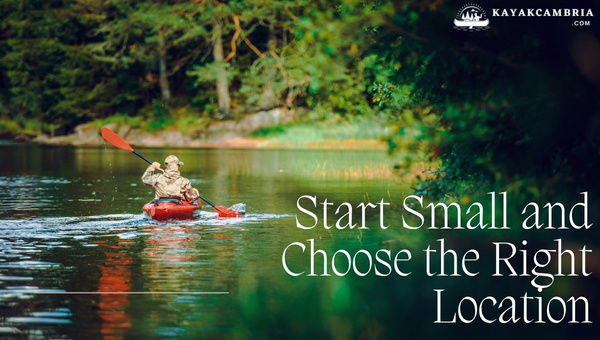
Before setting out on any solo adventure, especially as a novice or intermediate kayaker, it’s crucial to begin on calm and protected waters. I cannot stress enough the importance of selecting the perfect location to ensure a safe and enjoyable experience. Here’s what you should consider:
Know the water conditions and weather forecasts
It’s essential to familiarize yourself with the water conditions and check the weather forecast to avoid unexpected surprises and potential hazards. Refer to local guidebooks, websites, or simply speak with experienced kayakers in the area. Make a habit of monitoring the National Weather Service’s marine forecast for up-to-date information on weather conditions.
Choose locations with easy entry and exit points
As a solo kayaker, you want to make sure your chosen location is easily accessible. The best spots have launching ramps, sandy beaches, or gently sloping banks that allow you to get in and out of your kayak with minimal effort.
Look out for available facilities
When starting, it’s helpful to choose spots with available facilities such as parking, restrooms, and, if needed, kayak rentals. The presence of these facilities often indicates a popular and well-maintained area for kayaking. Websites such as Paddling.com offer a handy Launch Sites map to assist you in finding the best spots to embark on your solo adventure.
Selecting the right location is a crucial aspect of kayaking alone. Always prioritize staying informed on water conditions, choosing easily accessible paddling spots, and scoping out available facilities. These factors will contribute to a safer and more enjoyable solo kayaking experience.
Ensure You have The Proper Gear
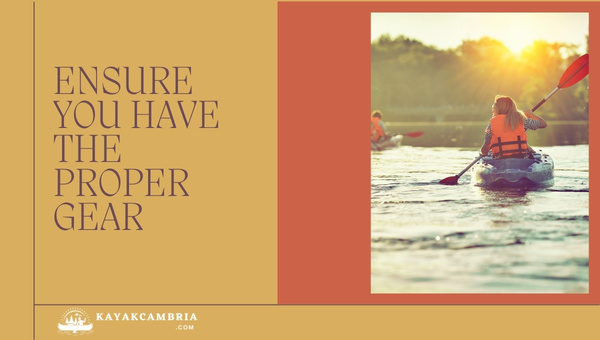
Having the right gear is essential for any kayaking excursion, especially when you’re setting out on your own. Gathering the appropriate equipment not only enhances your experience but ensures your safety while on the water. To set you off on your solo adventure, here’s a list of essential items to have with you:
1. Kayak
First and foremost, you’ll need a suitable kayak. Depending on your preferences, you can choose between a sit-on-top kayak, a sit-inside kayak, or even an inflatable one. To make the best decision, consider factors such as your experience, water conditions, and whether you plan to enjoy a leisurely paddle or a more challenging workout.
2. Personal Floatation Device (PFD)
Never head out for a solo paddle without an appropriately fitted personal floatation device (PFD) – it’s a non-negotiable safety requirement. Ensure your PFD is comfortable, allows for a wide range of motion, and meets local regulations.
3. Paddles
Choose well-fitted paddles, ensuring that they’re the right length for you and your kayak. A good rule of thumb is selecting a paddle that measures from the ground to your raised hand when standing. Additionally, consider investing in a paddle leash as well as a spare paddle for added security.
4. Bilge Pump and Sponge
It’s always wise to carry a bilge pump and sponge to help clear any water that may enter your kayak. This can help maintain balance and prevent unwanted capsizes during your solo kayaking adventure.
5. Clothing and Footwear
Wearing appropriate clothing and footwear can make a significant difference in your comfort and safety on the water. Consider factors like climate, water temperature, and sun exposure when selecting clothing, and opt for materials that dry quickly and offer UV protection. As for footwear, choose water-appropriate shoes or sandals with good grip for stability and protection.
By assembling the right gear for your solo kayaking trip, you can confidently embark on your adventure knowing that you’re well-prepared. Prioritizing your safety and comfort will enable you to fully enjoy the unforgettable experiences that come with kayaking alone.
Develop Essential Kayaking Skills
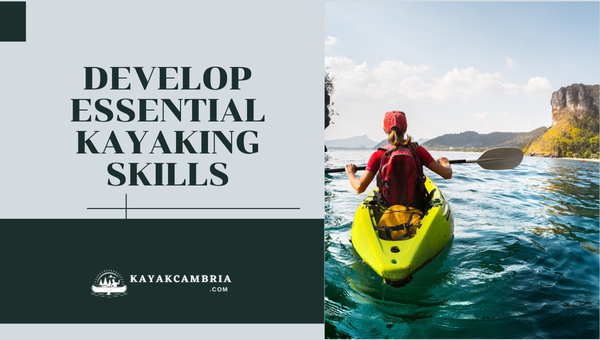
Before setting out on your solo adventure, it’s vital to master fundamental kayaking skills that are necessary for an enjoyable and safe journey. These skills will help you navigate the waters with ease and confidence and will serve you well in case of any unexpected situations.
Basic Paddling Techniques
Knowing the correct paddle strokes will allow you to be in complete control of your kayak. Make sure you are familiar with these essential paddle strokes:
- Forward Stroke: Used for propelling the kayak forward
- Reverse Stroke: Necessary for going backward or stopping the kayak
- Sweep Stroke: Helps in turning the kayak
- Draw Stroke: Allows for moving the kayak sideways
Balancing and Edging
To avoid capsizing, you need to understand how to maintain stability in your kayak. This includes mastering the art of balancing and edging, which will allow you to make sharper turns and avoid obstacles. Consider taking a course or practicing in calm waters to develop these skills.
Capsizing and Self-Rescue Techniques
As a solo kayaker, knowing how to handle a capsized situation and perform self-rescue techniques is vital. Some key methods to practice include:
- Wet Exit: Safely and calmly exiting a capsized kayak
- Re-Entry: Climbing back into the kayak after a capsize
- T-Rescue: A self-rescue technique using a float or paddle float for support
Weather and Water Condition Assessment
Being able to assess weather and water conditions is crucial for safety. Understanding the forecast beforehand, and reading the signs while on the water, will help you make well-informed decisions about your solo journey and avoid any potential hazards.
Developing these essential kayaking skills will ensure you are well-prepared for your solo adventure. The more comfortable you are with these techniques, the more confident and self-reliant you will be on the water, allowing you to thoroughly enjoy the unique experience of kayaking alone. Don’t hesitate to invest time and effort into mastering these valuable skills – it will undoubtedly pay off in the end.
Inform Someone Of Your Plans
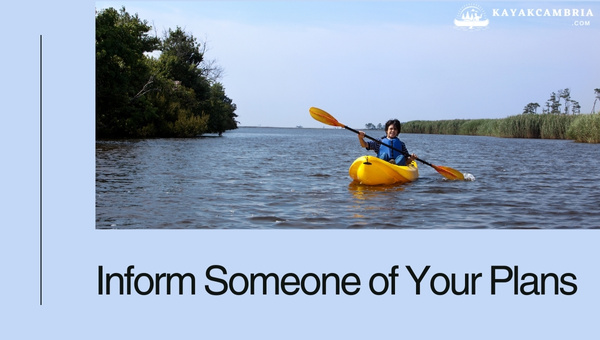
Before setting off for your solo kayaking adventure, it’s vital to inform someone responsible about your plans. Sharing your itinerary with a reliable person means that should anything unexpected occur while you’re out on the water, someone will know where you are and when they should expect your return. Take the time to discuss the following details:
Your Kayaking Route
Outline your intended paddling route, noting the specific water bodies you’ll be navigating and any unique landmarks nearby. This information can be vital during an emergency, as it allows others to pinpoint your location. Consider sharing GPS coordinates or even drawing a rough map if needed.
Estimated Duration
Let the person know how long you anticipate being on the water. Of course, exact durations can be difficult to predict, but a general estimate will help others gauge when they should start to worry if you haven’t returned or checked in.
Check-in Points
If your solo kayaking trip will span several days or cover a considerable distance, it’s a good idea to establish check-in points along your route. You can agree to call or send a message once you’ve reached or passed each designated point, which will reassure your contact that all is well.
Contact Information
Ensure your contact has a list of phone numbers and email addresses they can use to reach you, and provide them with the contact information for the local authorities, park rangers, or any relevant emergency services.
By taking the time to inform someone of your plans, it not only gives you peace of mind but also displays care and responsibility for those who care about you.
Carry Essential Safety Gear And Items
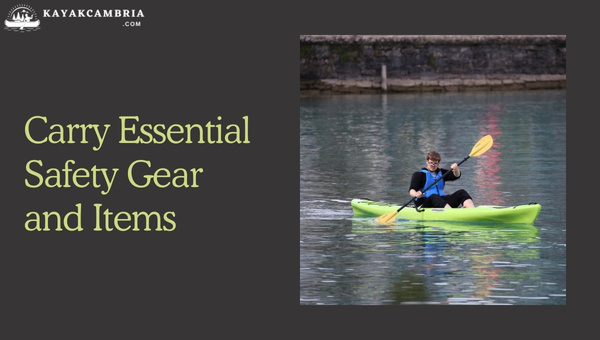
When heading out for a solo kayaking adventure, it is crucial to carry essential safety gear and items that will not only ensure a great experience but also help you stay out of harm’s way.
Personal Floatation Device (PFD)
Arguably the most important safety item for any kayaker is a properly fitted personal floatation device (PFD). Make sure it is comfortable and does not restrict your movements. A PFD with pockets can be an added bonus to store small items for easy access.
Whistle and Communication Device
Invest in a small, wearable safety whistle to use in case of emergencies to signal for help. It’s also wise to have a waterproof, fully charged phone or marine radio to stay in touch and call for help if needed. Store these items securely in a waterproof pouch or box.
Lighting and Visibility
Carrying a headlamp or flashlight is incredibly important, especially if there’s a chance you’ll be paddling in low-light conditions or after sunset. Additionally, consider attaching a high-visibility flag or reflective tape to your kayak to make you more visible to others.
Waterproof Dry Bag
Bring a waterproof dry bag to store important items like your wallet, keys and extra clothing. This will help ensure your belongings remain dry and safe during your journey.
Hydration and Nutrition
Pack an adequate amount of water and non-perishable snacks to stay hydrated and energized. Dehydration and lack of food can lead to fatigue and poor decision-making, which can be dangerous when paddling alone.
Sun Protection and First Aid Kit
Remember your sun protection essentials like sunscreen, sunglasses, and a hat. Don’t forget to bring a small first aid kit with essential items like band-aids, pain relief medication, and any personal medications you may need.
By carefully packing and carrying essential safety gear and items, you are ensuring that you are well-prepared for your solo kayaking adventure.
Be Aware Of Your Surroundings

While solo kayaking opens up a world of serenity and blissful solitude, it also comes with the responsibility of being vigilant and aware of your surroundings at all times. Being attentive is a crucial part of ensuring a safe and enjoyable journey on the water.
Observe Water Conditions and Hazards
Pay attention to the water’s current, tide, and any underwater obstacles, such as rocks or logs. Keep an eye out for changes in the weather – a calm day can quickly turn stormy, so be prepared to take appropriate action when needed.
Wildlife Encounters
Kayaking gives you a unique opportunity to observe wildlife up close. However, it’s crucial to maintain a respectful distance and avoid disturbing their natural habitat. For your safety, be aware of any potential encounters with potentially dangerous animals such as alligators, snakes, or sharks depending on your location.
Boats and Other Paddlers
While reveling in the beauty of nature, don’t forget to stay alert for other water users. Be mindful of the right-of-way rules for boats and maintain a safe distance from other kayakers, boaters, and swimmers.
To ensure you don’t lose your way, take note of landmarks along the shoreline and try to stay within sight of them. Familiarize yourself with the area map and bring a waterproof, portable version or a GPS device if possible.
Environmental Factors
Be conscious of your impact on the environment. Follow the Leave No Trace principles, and be sure to properly dispose of any trash. Do not disturb or remove any plants, rocks, or wildlife.
By maintaining situational awareness and a respectful and attentive attitude, you will not only ensure your safety but also preserve the beauty and tranquility of the environment for yourself and others to enjoy.
Remember: Safety first and respect the environment.
Know Your Limits And Paddle Responsibly
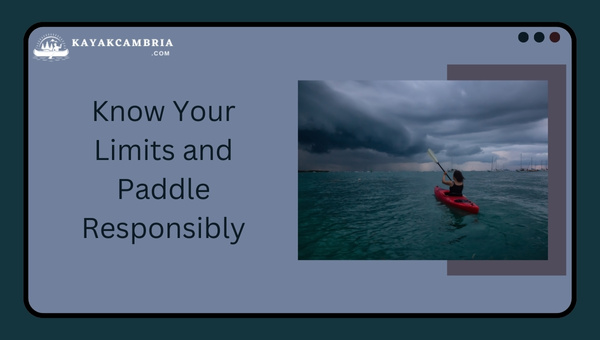
When embarking on a solo kayaking journey, it is crucial to recognize and respect your personal boundaries. Acknowledging your limits will help prevent accidents and ensure that you have an enjoyable experience while on the water.
Physical Abilities and Fitness
Be honest with yourself about your physical abilities and overall fitness level. If you’re new to kayaking or haven’t paddled in a while, you might want to consider shorter trips to build up your strength and endurance. It’s better to have a series of enjoyable and successful short trips than to push yourself too far and have a miserable or potentially dangerous experience.
Skill level and Experience
Evaluate your kayaking skills and experience realistically. You should be confident in your ability to handle the conditions you’ll encounter on your solo trip. If you’re unsure about how to handle a particular situation, take the time to learn and practice the necessary skills in a controlled environment before attempting it alone.
Weather and Water Conditions
Keep a close eye on weather forecasts and water conditions throughout your trip. Even if you are an experienced paddler, severe weather or rough water can quickly become dangerous. Be prepared to change your plans or turn back if conditions deteriorate unexpectedly.
Self-assessment and Intuition
Listen to your intuition and remember to continuously assess not just the environment around you, but also your own mental and physical state. If you’re feeling fatigued, stressed, or unsure about a situation, turn back or find a safe place to rest and regroup.
Here are some essential tips for paddling responsibly:
- Always wear a PFD and appropriate safety gear
- Regularly check weather forecasts and adapt your plans accordingly
- Practice self-rescue techniques and know how to call for help if necessary
- Respect local rules, regulations, and other watercraft users
- Leave no trace: Protect the environment by carrying out any trash, avoiding sensitive areas, and minimizing your impact on wildlife
By knowing your limits and paddling responsibly, you can relish in the beauty and serenity of solo kayaking while ensuring the safety and enjoyment of yourself and others.
Frequently Asked Questions
1. How do I choose the right kayak for solo kayaking?
When selecting a kayak for solo paddling, consider factors such as the type of water you will be paddling in, your skill level, and your budget. The three main types of kayaks are sit-on-top, sit-inside, and inflatable. For beginners, sit-on-top kayaks are generally more stable and easier to use. More experienced kayakers may prefer sit-inside kayaks for better control and performance. Inflatable kayaks offer the advantage of being portable and affordable.
2. How do I store and transport my kayak?
Storing and transporting your kayak can seem complicated, but with the right equipment and proper planning, it will be much more manageable. For storage, keep your kayak in a dry, covered area away from direct sunlight to prevent damage. If you lack space, consider using a wall-mounted or ceiling-mounted rack. For transportation, you can use a roof rack system with padded cradles or J-style holders on your vehicle. Alternatively, you can use a trailer specifically designed for carrying kayaks.
3. Is it safe to kayak alone?
While kayaking alone carries some inherent risks, it can be a safe and enjoyable experience if you take the necessary precautions. Pick a suitable location with calm water, develop essential kayaking skills, inform someone of your plans, carry safety gear, be aware of your surroundings, and know your limits to ensure a safe solo kayaking adventure.
4. Do I need any special clothing for solo kayaking?
When kayaking, it’s essential to dress appropriately for the weather and water conditions. In general, wear synthetic, quick-drying, moisture-wicking materials in layers, so you can easily adjust to changing temperatures. For colder conditions, wear a wetsuit or drysuit for insulation. Don’t forget essential accessories like a hat, sunglasses, gloves, and water shoes or sandals suitable for wet environments.
5. How can I improve my kayak paddling techniques?
Improving your kayak paddling techniques will make your solo kayaking experience much more enjoyable. Here are a few methods to enhance your skills:
– Take a kayaking course or join a paddling club to learn from experts
– Watch instructional videos and read books on kayaking
– Practice regularly on calm waters to improve your balance, control, and strength
– Focus on honing your skills such as paddle strokes, turning, steering, and self-rescue techniques
6. What should I do if I capsize while solo kayaking?
If you capsize during a solo kayaking trip, it’s essential to stay calm and follow these steps:
1. Perform a wet exit if you’re in a sit-inside kayak: unfasten your skirt, put your hands on the cockpit rim, and push yourself out using your hips.
2. Hold onto your paddle and make sure your kayak doesn’t drift away.
3. If using a sit-on-top kayak, flip the kayak upright and remount it from the back.
4. For a sit-inside kayak, attempt a self-rescue technique like re-entering from the water or using a paddle float for stability.
5. Once back in your kayak, use a bilge pump to remove any water.
7. Are there any age restrictions or health concerns for solo kayaking?
For the most part, kayaking is an accessible sport for individuals of various ages and fitness levels. However, when it comes to solo kayaking, it’s essential that the individual has the necessary skills, experience, and physical ability to paddle alone and handle any emergencies. If you have any medical conditions or concerns, it’s always wise to consult your doctor before taking up solo kayaking.
Conclusion
Solo kayaking can truly be a remarkable and transformative experience. It allows you to connect with nature, revel in peaceful solitude, and challenge yourself. As you embark on this exciting journey, it’s important to always keep safety as a top priority. By starting small, choosing the right location, mastering essential kayaking skills, and staying prepared, you’ll be well on your way to enjoying the many benefits of solo kayaking.
Remember, the key to success lies in knowing your limits, understanding your surroundings, and being well-equipped for any situation that comes your way. So gather your gear, inform someone of your plans, and set out on an unforgettable and rewarding adventure!

